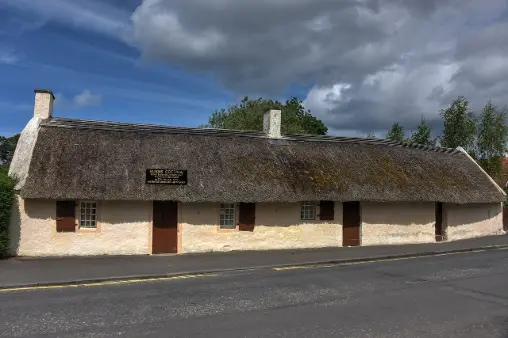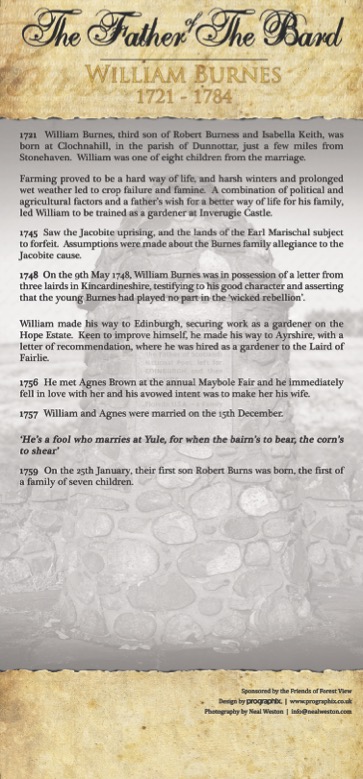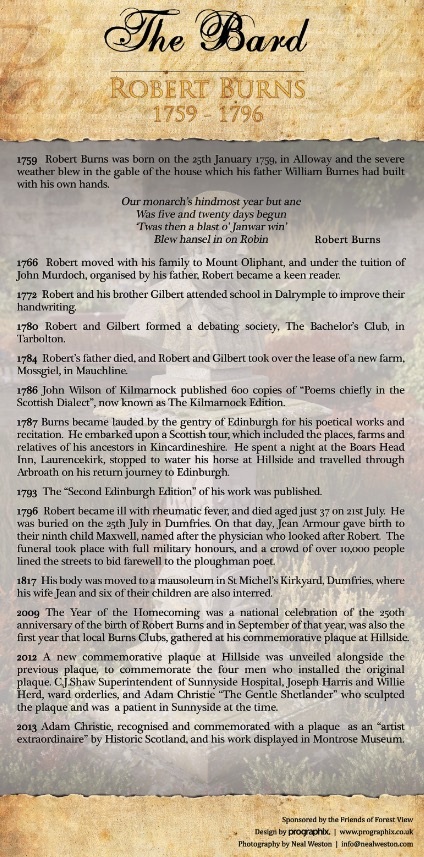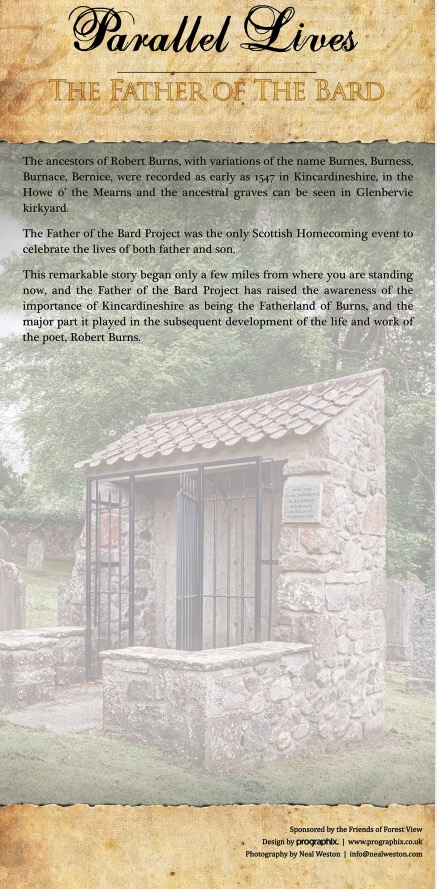Robert Burns History
Robert Burns:
Scotland’s Bard, A Life in the Rhyme and Rhythm of the Land
Ah, Rabbie Burns! The name evokes images of kilts swirling at ceilidhs, the smoky warmth of a haggis supper, and the heartfelt crooning of “Auld Lang Syne” on New Year’s Eve. But who was the man behind the legend? What was his families life like before the young Burns came into the world and what formed him into the young man that wrote all the poems and songs that have become synonymous with Scotland itself?

Humble Beginnings in Alloway’s Rolling Hills

Born in a humble cottage in Alloway, Ayrshire, on 25th January 1759, Burns’ life began surrounded by the rolling hills and rugged beauty of the Scottish countryside.
The Burns story begins however with his father, William Burnes who was born in 1721 at Clochnahill, in the parish of Dunottar, Aberdeenshire.
Farming on the East coast of Scotland proved to be a hard way of life, and harsh weather and prolonged wet weather led to crop failure and famine. A combination of political and agricultural factors and a father’s wish for a better way of life for his family, led William to be trained as a gardener at Inverugie Castle, near Peterhead.
On the 9th May 1748, William Burnes was in possession of a letter from three lairds in Kincardineshire testifying to his good character and asserting that the young Burnes had played no part in the “wicked rebellion”.
William made his way to Edinburgh, securing work as a gardener on the Hope Estate. Eager to improve himself, he made his way to Ayrshire with a letter of recommendation, where he was hired as a gardener to the Laird of Farlie.
He met Agnes Brown at the annual Maybole fair in 1756 and he immediately feel in love with her and his avowed intent was to make her his wife. William and Agnes were married on the 15th December 1757.
‘He’s a fool who marries in Yule, for when the bairn’s to bear, the corn’s to shear’
As we know on 25th January 1759, their first son Robert Burns was born, the first of a family of seven children.
Together they instilled in young Robert a deep love for learning and the natural world.
The Bard – Robert burns 1759 -1796
 Robert Burns was born on the 25th Jan 1759 in Alloway and severe weather blew in the gable of the house which his father William Burnes had built with his own hands.
Robert Burns was born on the 25th Jan 1759 in Alloway and severe weather blew in the gable of the house which his father William Burnes had built with his own hands.
(The Words from Burns’ Poem, (Rantin’ Rovin’ Robin) Describing his own Entry to the World)
Our monarch’s hindmost year but ane
Was five and twenty days begun
‘Twas then a blast o’ Janwar win’
Blew hansel in on Robin
Robert moved with his family to Mount Oliphant in 1766, and under the tuition of John Murdoch, organised by his father, Robert became a keen reader.
Robert and his brother Gilbert attended school in Dalrymple in 1772 to improve their handwriting.
In 1780 Robert and his brother Gilbert formed a debating society, The Batchelor’s Club, in Tarbolton. A club on which Montrose Burns Club modelled itself upon when founded in 1909.
Robert’s father died in 1784 and Robert and Gilbert took over the lease of a new farm, Mossgeil, in Mauchline.
In 1786 John Wilson of Kilmarnock published 600 copies of “Poems chiefly in the Scottish Dialect”, known as The Kilmarnock Edition.
This launched Burns, and in 1787 he became lauded by the gentry of Edinburgh for his poetical works and recitation. He embarked upon a Scottish tour which included the places, farms and relatives of his ancestors in Kincardineshire. He spent a night in the Boar’s Head Inn, Laurencekirk, stopped to water his horse at Hillside, stayed the night in Montrose and travelled through Arbroath on his return journey to Edinburgh.
The “Second Edinburgh Edition” of his work was published in 1793.
Robert became ill during 1796 with rheumatic fever, and died aged just 37 on 21st July. He was buried on the 25th July in Dumfries. On that day, Jean Armour gave birth to their ninth child Maxwell, named after the physician who looked after Robert. The funeral took place with full military honours, and a crowd of over 10,000 people lined the streets to bid farewell to the ploughman poet.
1817 – His body was moved to a mausoleum in St Michel’s Kirkyard, Dumfries, where his wife Jean and six of his children are also interred.
2009 – The Year of the Homecoming was a national celebration of the 250th anniversary of the birth of Robert Burns and in September of that year, was also the year that local Burns clubs gathered at his commemorative plaque in Hillside.
2012 – A new commemorative storyboard was unveiled alongside the original stone plaque, to commemorate the four men of Hillside who installed the original plaque in 1930, C.J. Shaw Superintendent of Sunnyside Hospital, Joseph Harris and Willie Herd, ward orderlies, and Adam Christie “The Gentle Shetlander” who sculpted the plaque and was a patient in Sunnyside at that time.
Burns’ life was a tapestry woven with love and loss, laughter and tears. He had numerous romantic relationships, including his tumultuous love affair with Jean Armour, whom he eventually married in 1788. Theirs was a passionate but complicated union, tested by societal pressures and Burns’ own struggles with financial hardship and ill health
William Burnes’ Life
 In 1764 William appointed John Murdoch as tutor to Robert and his younger brother Gilbert.
In 1764 William appointed John Murdoch as tutor to Robert and his younger brother Gilbert.
As the family grew, and outgrew their original home, and with financial support from his employer, William Burness took on the lease of a farm at Mount Oliphant in 1766.
The family moved to the farm of Lochlea in 1777, which was to lead to a troubled time with poor land, an expanding family and overstretched financially. The death of his benefactor saw the appointment of a factor for the estate who had a harsh and clear objective about the repayment of debts outstanding.
This saw William Burnes plunged into legal arguments about the conditions of his lease, and the subsequent stress and strain upon the whole family became intolerable.
The latter years of William’s life were an unhappy mix of hardship, worry, litigation and failing health. On 13th February 1784, William Burnes died from consumption with his family around him, and with Rober being his final source of concern. “There is only one of you all I am afraid for” were his dying words.
The funeral procession left Lochlea Farm, and travelled on foot for the eight mile journey to the old Kirkyard at Alloway, where he was finally laid to rest.
Epitaph On my Ever Honoured Father
“O ye whose cheek the tear of pity stains,
Draw near with pious rev’rence, and attend!
Here lie the loving husband’s dear remains,
The tender father, and the gen’rous friend;
The pitying heart that felt for human woe,
The dauntless heart that fear’d no human pride;
The friend of man – to vice alone a foe;
For “ev’n his failing lean’d to virtue’s side” Robert Burns
Paralell Lives-The Father of the Bard

The ancestors of Robert Burns, with variations of the name Burnes, Burness, Burnace, Bernice, were recorded as early as 1547 in Kincardineshire, in the Howe o’ the Mearns and the ancestral graves can be seen in the Glenbervie kirkyard.
The Father of the Bard Project was the only Scottish Homecoming event to celebrate the lives of both father and son.
This remarkable story began only a few miles from where you are standing now, and the Father of the Bard Project has raised the awareness of the importance of Kincardineshire as being the Fatherland of Burns, and the major part it played in subsequent development of the life and work of the poet, Robert Burns.
